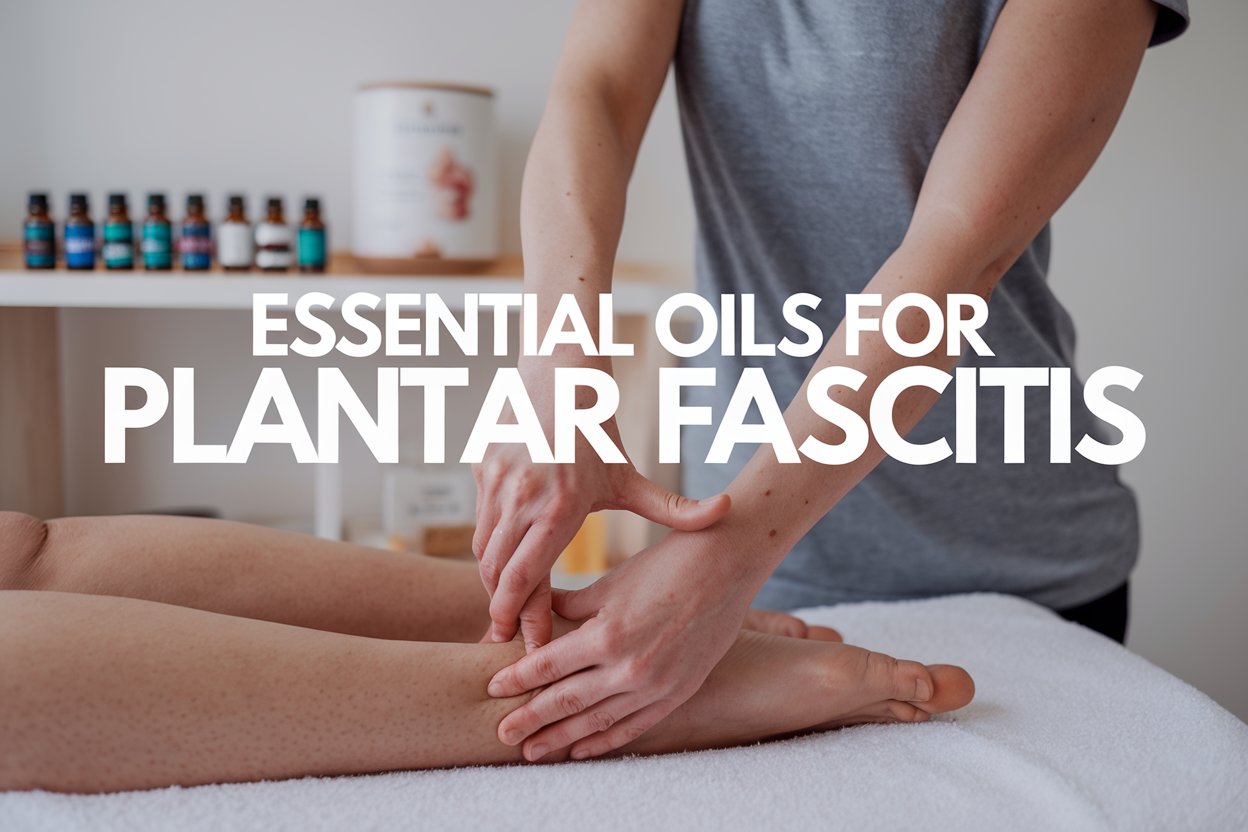Relieve Plantar Fasciitis with Essential Oils

Imagine waking up feeling great, but then feeling a sharp pain in your heel when you step out of bed. This is a common problem for many, known as plantar fasciitis. It makes simple tasks like walking or running very painful. Many people look for natural ways to ease this pain.
Essential oils for plantar fasciitis are a popular choice. They offer relief from pain and a pleasant scent. Oils like frankincense and peppermint are known for their calming and anti-inflammatory effects. We’ll explore how these oils can help you find relief from foot pain.
Table of Contents
Understanding Plantar Fasciitis
Plantar fasciitis is a common foot condition that causes ongoing foot pain. It happens when the plantar fascia, a tissue band at the foot’s bottom, gets inflamed. This tissue connects the heel bone to the toes. Many people feel pain that gets worse after resting or when they wake up.
Being older, carrying extra weight, and being active can increase the risk of getting plantar fasciitis. Men and women aged 40 to 70 who are active often get this condition. Carrying extra weight puts more stress on the plantar fascia. Also, those who do a lot of running or high-impact sports are more likely to get it.
How your foot is shaped can also affect your risk. If you have high arches or flat feet, or tight Achilles tendons, you’re more likely to get plantar fasciitis. Wearing shoes that don’t support your arches while standing or doing activities can make it worse.
Early intervention is essential for managing pain and preventing complications associated with plantar fasciitis.
Understanding the factors that lead to plantar fasciitis is key. It helps find solutions that ease foot pain and improve foot health.
| Risk Factors | Description |
|---|---|
| Age | Most common in individuals aged 40-70. |
| Weight | Overweight and obese individuals experience increased pressure on the plantar fascia. |
| Activity Level | Active people, especially long-distance runners, are more susceptible. |
| Foot Structure | High arches, flat feet, and tight Achilles tendons heighten risk. |
| Shoe Quality | Poor arch support and inadequate footwear can contribute to foot pain. |
What Causes Plantar Fasciitis?
Plantar fasciitis is mainly caused by straining the plantar fascia, a strong ligament that helps support the foot’s arch. Standing for a long time, playing high-impact sports, and not wearing proper arch support are big reasons for foot pain. These activities can cause small tears in the fascia, leading to inflammation and pain.
Other things can also make you more likely to get plantar fasciitis:
- Being overweight puts more stress on the plantar fascia, making it more prone to injury.
- As people get older, their ligaments lose elasticity, making older adults more at risk.
- Having flat feet or high arches can put uneven stress on the plantar fascia.
Knowing what causes plantar fasciitis helps in finding ways to prevent and treat it. Making lifestyle changes, like eating foods that reduce inflammation, can help with healing. It’s also key to stay active with low-impact activities like swimming, cycling, or yoga while you recover. Getting help from a professional can give you more ways to manage foot pain. For more tips, check out this resource on chiropractic care.
Common Symptoms of Plantar Fasciitis
It’s important to know the signs of plantar fasciitis to get help early. The main symptom is sharp pain in the heel. This pain is usually worse when you first get up or after sitting a lot. It may get better as you move around, but can come back after standing or doing hard activities.
Other signs of this condition include:
- Stiffness: Many people feel their Achilles tendon is stiff along with the heel pain.
- Swelling: You might see swelling around the heel and ankle.
- Arch Pain: Pain in the arch of the foot is also common in those with plantar fasciitis.
Some people might also have heel pain from other conditions like lupus or rheumatoid arthritis, but this is not common. How long and how bad the symptoms are can affect treatment time. Athletes who do a lot may take longer to recover.
| Symptom | Description |
|---|---|
| Heel Pain | Sharp pain near the heel, especially noticeable in the morning or after inactivity. |
| Stiffness | Tightness felt in the Achilles tendon and surrounding areas. |
| Arch Pain | Discomfort experienced in the arch of the foot. |
| Swelling | Visible swelling around the heel and ankle joint. |
Keep an eye on these symptoms and get the right care to manage plantar fasciitis. If you have heel pain that doesn’t go away after a week, see a doctor to find out what to do next.
How Essential Oils Work for Pain Relief

Essential oils can help ease plantar fasciitis pain naturally. They work by reducing inflammation and calming the area. When applied to the skin, these oils go straight to the source of pain.
Studies have found that oils like frankincense and lavender can lessen inflammation. This makes them great for managing pain with essential oils. People using these oils often see a big drop in their pain levels.
Using ice for twenty minutes several times a day can also help reduce inflammation. Wearing a splint at night stretches the tissues and aids healing. Adding low-impact activities like swimming, cycling, and yoga can also help without putting too much strain on the affected areas.
Adding essential oils to a treatment plan that includes healthy eating can boost results. Eating foods that fight inflammation and avoiding alcohol and sugary drinks can help manage pain better. This approach can lead to better pain relief and overall health.
| Essential Oil | Primary Benefits | Application Method |
|---|---|---|
| Frankincense | Reduces inflammation, promotes relaxation | Topical application or diffusing |
| Lavender | Calms nerves, alleviates pain | Topical application or inhalation |
| Peppermint | Soothes muscle tension, invigorates | Topical application or inhalation |
| Birch | Anti-inflammatory, pain relief | Topical application |
Benefits of Using Essential Oils for Plantar Fasciitis

Essential oils offer a natural way to ease foot pain. Many people find them helpful for plantar fasciitis. Oils like lavender and peppermint work well with other treatments.
Lavender oil has been shown to ease pain as much as some prescription drugs. This shows a good alternative to traditional painkillers. Bergamot oil, with its linalool content, also helps by reducing pain and inflammation.
Peppermint oil is famous for easing muscle pain. Ginger oil is known for its strong anti-inflammatory effects. This helps lessen the pain of plantar fasciitis.
Frankincense oil helps with pain and improves blood flow. It also supports the immune system. After surgery, some people use eucalyptus oil to help with pain and swelling. Basil oil has also been used to lessen pain from inflammation.
To get the most out of essential oils, try a foot massage. Mix five drops of your chosen oil with one tablespoon of carrier oil to prevent skin issues. Or, take a warm foot bath with essential oils for five to ten minutes to ease plantar fasciitis pain.
The table below summarizes some essential oils and their specific benefits for managing plantar fasciitis:
| Essential Oil | Benefits |
|---|---|
| Lavender | Natural pain relief comparable to opioid medications |
| Bergamot | Reduces pain through anti-inflammatory properties |
| Peppermint | Known for its analgesic properties that relieve muscle pain |
| Eucalyptus | Provides pain and inflammation relief through inhalation |
| Ginger | Effective in reducing inflammation |
| Frankincense | Eases pain, improves circulation, boosts immune function |
| Basil | Reduces pain, swelling, and inflammation |
Using essential oils can be a holistic way to fight foot inflammation. They can help you recover from plantar fasciitis. With different ways to use them, essential oils can make you feel better and more comfortable.
Essential Oils for Plantar Fasciitis: An Overview

Essential oils can help people with plantar fasciitis feel better. They are known for reducing inflammation and easing pain without harmful side effects. Oils like lavender, frankincense, and peppermint are great for foot pain. Each oil has special properties that help with different symptoms.
To use essential oils, mix them with carrier oils like jojoba or coconut oil. Use 2-3 drops per teaspoon for topical applications. This method helps target pain directly on the affected areas. Foot soaks are another good way to use essential oils. Add them to warm water with Epsom salts for relaxation and pain relief.
While there’s not much science backing the use of essential oils with Epsom salts, many people find them helpful. They are affordable and safe to try. Combining essential oils, Epsom salts, orthotic inserts, and stretching exercises can lead to effective pain relief. This approach helps users find the best solutions for their needs, promoting healing and wellness.
Best Essential Oils for Foot Pain Relief
Finding relief from foot pain can be tough. But, using the best essential oils for foot pain might help. These oils offer quick comfort and can help heal over time. Here are some top picks:
Lavender Essential Oil
Lavender essential oil is known for its calming effects and anti-inflammatory properties. Massaging it into your feet can soothe discomfort. Studies show it’s great for reducing inflammation, especially for plantar fasciitis.
Frankincense Essential Oil
Frankincense oil is an ancient remedy that fights inflammation and supports cell health. It targets chronic pain and boosts overall well-being. Its powerful properties make it a top choice for foot pain relief.
Peppermint Essential Oil
Peppermint essential oil is known for its refreshing and cooling effect. It helps ease discomfort quickly. The oil improves blood flow, which is great for foot pain. Its scent also adds a pleasant touch, making it a favorite for quick relief.
| Essential Oil | Main Benefits | Application Tips |
|---|---|---|
| Lavender Essential Oil | Calming, anti-inflammatory | Mix with a carrier oil for foot massage. |
| Frankincense Essential Oil | Reduces inflammation, promotes healing | Add to foot soaks or massage directly on foot. |
| Peppermint Essential Oil | Cooling sensation, stimulates circulation | Inhale directly or dilute for topical use. |
Trying out these essential oils can bring significant relief from foot pain. It can improve comfort and quality of life. Consider adding these oils to your daily routine for the best results.
Essential Oil Blends for Plantar Fasciitis Relief
Finding relief from plantar fasciitis often requires a mix of methods. Essential oil blends can help a lot by easing pain and aiding healing. They focus on reducing inflammation and improving blood flow. These are key to easing the pain of this condition.
DIY Essential Oil Blend Recipes
Creating your own essential oil blends can be fun and helpful. Here are some easy DIY recipes:
- Soothing Foot Massage Oil: Mix 2-3 drops of lavender and peppermint essential oils with a teaspoon of coconut oil. Massage this blend into the affected areas for relief.
- Healing Foot Soak: Add a few drops each of frankincense and tea tree essential oils to warm water for a soothing foot bath.
- Refreshing Treatment Gel: Combine aloe vera gel with lavender and tea tree essential oils for a soothing application on the inflamed heel.
These DIY essential oil recipes help ease pain and offer a relaxing experience. This can improve your overall well-being.
How to Properly Dilute Essential Oils
It’s important to know how to dilute essential oils safely. A good rule is to mix 2-3 drops of essential oil with 1 teaspoon of a carrier oil, like coconut or jojoba oil. This way, the essential oils’ strength is balanced, reducing the risk of skin irritation.
Correct dilution helps with absorption and boosts the healing effects of essential oils for plantar fasciitis. Always test a small area first to check for any bad reactions before using it on a bigger area. By doing this, you can safely enjoy the many benefits essential oils offer.
For more info on natural remedies and their effects, check out this useful resource.
Aromatherapy for Plantar Fasciitis
Aromatherapy for plantar fasciitis offers a holistic way to ease foot pain and boost comfort. Essential oils help with both physical and emotional health. They provide relief through methods like diffusion and inhalation therapy. These practices can greatly help in managing plantar fasciitis discomfort.
Using Diffusers for Foot Pain Relief
Using essential oils in a diffuser is a great way to create a calming space. When heated, the oils spread lovely scents that can lessen stress and encourage relaxation. This is a wonderful addition to your wellness routine. The diffuser benefits go beyond just the smell, as breathing in these scents can help with pain management. Diffusers can keep sending out healing aromas all day, offering constant comfort.
Benefits of Inhalation Therapy
Inhalation therapy uses the scents from essential oils to help those with plantar fasciitis. It can lessen stress and make a space more relaxing, which is key for pain relief. Deep breathing with these scents can clear the mind and help you relax, which also helps with pain.
By adding inhalation therapy with essential oils to your daily life, many people see a big improvement in their comfort and ability to handle foot pain.
Applying Essential Oils for Effective Treatment
Using essential oils is a simple way to help with plantar fasciitis. Oils like lavender, peppermint, tea tree, and frankincense are popular for their benefits. You can massage these oils into the sore area to ease pain and improve blood flow. This method not only helps with pain but also makes self-care more relaxing.
Some essential oils have special benefits. For example, frankincense oil has boswellic acid that fights inflammation. Peppermint oil can ease joint and muscle pain. Lemongrass oil helps lessen redness and swelling from plantar fasciitis. But, there’s no scientific proof that essential oils are a cure for foot pain.
It’s important to mix essential oils with a carrier oil before applying them. This prevents allergic reactions or skin irritation. Adding these oils to your routine can make dealing with pain easier.
| Essential Oil | Benefits | Precautions |
|---|---|---|
| Frankincense | May reduce inflammation, a traditional remedy | Should be diluted to avoid skin irritation |
| Peppermint | Relieves headaches, joints, and muscle pain | Test for sensitivity before full application |
| Lemongrass | Reduces redness and swelling | Use cautiously to mitigate allergic reactions |
| Lavender | Soothing effects and anti-inflammatory properties | Ensure proper dilution to avoid rashes |
Essential oils are cheaper than some other treatments like orthotics and ice packs. Using them along with stretching and ice can help with plantar fasciitis. This approach might improve your symptoms.
Other Natural Remedies for Plantar Fasciitis
Dealing with plantar fasciitis often means trying different things. Using essential oils is just the start. Adding stretching exercises and ice therapy with foot massage can really help. These methods ease pain and boost your foot health.
Stretching and Strengthening Exercises
Stretching regularly can change the game for plantar fasciitis sufferers. Focus on stretching your calf and plantar fascia to get better flexibility and less pain. Here are some exercises you can try:
- Calf Stretch: Stand facing a wall and place one foot forward with the knee bent and the other leg straight behind. Hold the stretch for 15-30 seconds.
- Plantar Fascia Stretch: Sit down and place a towel around your foot. Gently pull towards you for a soothing stretch.
- Toe Curls: While seated, place a towel on the floor and use your toes to scrunch it towards you. This strengthens the foot muscles.
Ice Therapy and Foot Massage
Ice therapy is great for reducing inflammation from plantar fasciitis. Applying ice packs for 15 to 20 minutes helps ease pain and swelling. Foot massage also offers big benefits. Here’s how:
- Self-Massage: Use your fingers to massage the arch of your foot. Apply gentle pressure, focusing on any painful areas.
- Foot Roll: Roll a frozen water bottle or a tennis ball under your foot for a revitalizing massage while soothing inflammation.
- Essential Oil Blend Massage: Combining essential oils with massage techniques enhances relaxation. Use oils like lavender mixed with a carrier oil for added benefits.
Adding these natural remedies to your daily routine can help fight plantar fasciitis. Stretching exercises boost mobility. Ice therapy and foot massage aid in recovery and relief. Try these methods for a more comfortable life with plantar fasciitis.
When to Seek Professional Help
Knowing when to get help for plantar fasciitis is key to getting better. If home remedies, like using essential oils, don’t help, it’s time to see a doctor. This condition often affects active people, especially those in their 40s and 50s.
Doctors might suggest physical therapy to strengthen your foot’s muscles and tendons. Sometimes, custom orthotics are needed to help with weight distribution and support. If these methods don’t work, corticosteroid injections can help reduce swelling.
If you’ve had plantar fasciitis for over six months, surgery might be an option. But, recovery can take a while. Catching it early can make treatment shorter. So, don’t wait to see foot specialists for the right diagnosis and treatment plan.
FAQ
What are the best essential oils for plantar fasciitis?
How can essential oils help with heel pain relief?
Can I mix essential oils for foot pain relief?
How do I properly dilute essential oils for application?
What are some natural remedies for plantar fasciitis?
Can aromatherapy help manage plantar fasciitis pain?
When should I seek professional help for my plantar fasciitis?
Is there any research supporting the use of essential oils for plantar fasciitis?
Are there side effects to using essential oils for foot discomfort?
How can I apply essential oils for effective treatment of plantar fasciitis?







